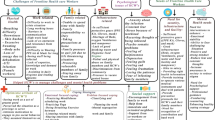Abstract
Support groups provide information and emotional support to families. Despite a recent growth in the number and size of these groups, there are no formal structures in place to provide support for the support worker. We performed a cross-sectional survey using a self-completion postal questionnaire, with the aim of identifying the structure, training needs and support given to workers. The participants were support workers from 112 United Kingdom-based organisations listed on the ‘Contact a Family’ website (www.cafamily.co.uk). We received 104 replies from 50/112 organisations (44%). Of these, 94/104 (90%) worked from home as volunteers. Two-thirds, 69/104, admitted times when they struggled to cope. A total of 43 (41%) admitted occasions of concern over the care given by a client to their affected relative. No group employed a professional to act in a clinical supervisory role. Our study suggests that support workers are highly committed to their role; these workers need support to ensure that they give appropriate advice under difficult circumstances.
Similar content being viewed by others
Introduction
The ‘Contact a family’ organisation, (www.cafamily.co.uk), which started in 1991, works across the UK to provide information and support for families who care for children with any kind of special need, disability or medical condition.1 Contact a family (CaF) helps parents who wish to start or develop mutual support groups acting as an umbrella organisation for about 300 national groups, all of whom are listed in the CaF directory. They give practical advice to individuals wanting to set up a support group by providing information packs and organising training courses. The general advice and recommendations include: the importance of time management, not letting the group interfere with family life, not taking on individual family problems and reducing group commitment if necessary. CaF also recommend that volunteers protect their privacy by avoiding using their own personal address and telephone line. There is a similar group in Europe known as Eurordis (www.eurordis.org), although this group strictly provides support for rare disorders only. The aim of this paper is to describe the structure of support groups in the UK, to identify the training and support given to workers and to establish the working patterns among group workers.
Method
We performed a cross-sectional survey using a self-completion postal questionnaire incorporating fixed and open-ended questions. We identified 112 support groups from the ‘Contact a family’ website, which encompass all common chromosomal, genetic and sporadic conditions. Large groups were sent 10 and smaller groups five questionnaires with a letter and information leaflet signed by the two authors. CaF was aware of our study and offered to forward our questionnaire through their network. The completed questionnaires were collected over the following 4 months.
The questionnaires were anonymous and incorporated 24 fixed-choice and open-ended questions. Our main outcome measures were: the structure of the organisation, the number of respondents working voluntarily and hours worked; place of work; protection of privacy if a home worker; the method used to give information; training needs; coping mechanisms and support available for staff if problems arise in their work. Fixed-choice questions were analysed using the statistical package SPSSX. For some questions, more than one answer could be given. Some respondents did not answer all questions.
Results
Of the 112 groups that we contacted, 50 (44%) returned completed questionnaires. Two groups returned uncompleted forms and there were 60 nonresponders. Some groups completed more than one questionnaire; therefore, a total of 104 replies were received from the 50 groups. Analysis is based on these 104 questionnaires. The results are summarised in Table 1. Some of the respondents’ comments are illustrated in Table 2. Of the 104 completed questionnaires, 94 (90%) respondents worked from home as volunteers. The majority (85%) of workers were females. One-third (31/104) were affected and 2/3 (68/104) had an affected relative. In all, 51 (49%) of the respondents made themselves available 24 h a day. The majority, 74/104 (71%), had no formal training and, although 36/104 (35%) said they would welcome this, the majority, 45/104 (43%), did not want training. A total of 51 (49%) of the respondents made themselves available 24 h a day. Only a third (34/104) used dedicated answer phones or telephones at home, as advised by CaF. Two-thirds, 69/104, admitted times when they struggled to cope. In total, 43 (41%) admitted concern over the care given by a client to an affected relative, and 81 (78%) said they would like a structured support network. No group employed an independent clinical supervisor.
Discussion
Previous studies on support groups have focused on patient benefits of belonging to such a group,2,3 or the relationship between support groups and professionals.4,5 Prior to this, no one has canvassed the opinions of support group workers to establish the level of commitment involved or the problems that might occur. While 62 (of the original 112 groups contacted) failed to return the questionnaire, the 50 groups who did respond represent large-, medium- and small-size groups. The information sheet accompanying the questionnaire requested their help to establish whether group workers can access support in a similar fashion to HCPs working within the NHS. However, some workers might have been deterred from completing the questionnaire because of its origin, and this might have influenced the nature of replies. We had hoped to canvass the views of more workers from larger organisations in the hope of identifying a more structured support network within these large groups. However, only 19 respondents came from a group with 50 or more workers. Despite this, there was no evidence that they received more support than other workers. It is possible that our findings could reflect nonresponse bias, although CaF is not aware of any group that has a structured support system (personal communication). It is clear from our results that support group workers are a highly committed group. Most are females, who work on a voluntary basis from home. Two-fifths of the workers make themselves available 24 h a day 7 days a week, with many offering advice, not only on the telephone, but also through the Internet. One respondent commented, ‘I suffer from information overload by e-mail and too many demands on my time but no one to delegate to’ and added, ‘I often don’t sleep well for thinking about email exchanges’. Home workers are a particularly vulnerable group; CaF recommend that such workers use a dedicated answer phone. In our survey, we found that a significant minority were ignoring this advice and allowed unrestricted access to their home telephone. Many workers mentioned the importance of always being there for the first-time caller, with one commenting, ‘it is particularly important to share your experiences with a first time caller – it helps with the feelings of isolation’. It is clear that the dilemma facing workers is that, in allowing open access, they risk losing their privacy. Only one group insisted on dedicated answer phones, following difficulties for staff when a client began making nuisance telephone calls at random.
CaF organises training courses for workers, but few from our survey had attended. The majority had no formal training; most felt that training was not necessary and some felt it might be detrimental. The majority discuss their own experiences with their clients. One respondent added, ‘I am a parent of an affected child which means I am probably more qualified than medical professionals’.
Two-thirds admitted that there were times when their job was stressful and they found it difficult to cope. Most discussed difficult cases with a colleague or relative, although one respondent, a director of a support group, felt isolated and unable to voice concerns because of their position within the group. A significant minority admitted concerns regarding the care of a client or clients with one worker acknowledging difficulties with a suspected child-abuse case and another worker commenting, ‘I wasn’t sure how to react when a mother told me she wished her son was dead – in front of him’. Comments like this are clearly distressing, especially when research has shown that disabled children are more likely to suffer abuse than able-bodied children.6,7 Health-care professionals are obliged by law to refer suspected cases of child abuse to the social services; there is no such obligation for support group workers. Previous research has shown that support for families of disabled children/adults is critical;2,3 support workers may be the only link families under stress will use. If we are to optimise that link, HCPs need to offer support to the worker as well. A formal arrangement with an experienced professional would allow workers to discuss difficult or stressful issues in confidence. This service could be administered centrally by CaF, as it is in other organisations. In the NHS, this process is called Clinical Supervision; it is accessible by all staff and is organised on a departmental basis. Using existing expertise within the CAF organisation avoids raising anxieties by workers who could feel less inclined to voice concerns about a child in case it led to direct action against a family. However, internal existing expertise could also result in workers being less vocal about the stress they are under and their ability to cope, therefore proving more restrictive than an independent service. While our study suggests that support workers are exposed to difficult cases, further research needs to be carried out in the form of a pilot study to compare independent and internal supervisory services in an effort to quantify the concerns highlighted and evaluate the potential benefit of supervision.
References
Patton MA : Useful information about rare inherited disorders. Br Med J 2003; 326: 612.
Law M, King S, Stewart D, King G : The perceived effects of patient-led support groups for parents of children with disabilities. Phys Occup Ther Pediatr 2001; 21: 29–48.
Knight B, Wollert RW, Levy LH, Frame CL, Padgett VP : Self-help groups: the member's perspectives. Am J Comm Psychol 1980; 8: 53–65.
Ben-Ari AT : Dimensions and predictions of professional involvement in self-help groups: a view from within. Health Soc Work 2002; 27: 95–103.
Black ME : Self help groups and professionals – what is the relationship? Br Med J 1988; 296: 1485–1486.
Waldman HB, Swerdloff M, Perlman SP : A ‘dirty secret’: the abuse of children with disabilities. J Dent Child 1999; 197–202.
Cooke P, Standen PJ : Abuse and disabled children: hidden needs…? Child Abuse Rev 2002; 11: 1–18.
Williamson GR, Dodds S : The effectiveness of a group approach to clinical supervision in reducing stress: a review of the literature. J Clin Nurs 1999; 8 (4): 338–344.
Acknowledgements
We thank all the respondents for completing the questionnaire and Janet Brooks for secretarial support. We thank Judith Rankin for helpful comments. We thank Anna Woods and Liz Ranger from Contact a family for advice and help. We thank Carol Hellier and Steve Henderson from the university computing service for analysing the questionnaire. Funding: The Northern Genetics Knowledge Park helped finance this project. There are no conflicts of interests.
Author information
Authors and Affiliations
Corresponding author
Rights and permissions
About this article
Cite this article
McDonnell, S., Lynch, S. Who supports the support workers? Cross-sectional survey of support workers’ experience and views. Eur J Hum Genet 12, 251–254 (2004). https://doi.org/10.1038/sj.ejhg.5201148
Received:
Revised:
Accepted:
Published:
Issue Date:
DOI: https://doi.org/10.1038/sj.ejhg.5201148



